MXA’S 2023 250 FOUR-STROKE SHOOTOUT: THE FINAL WORD ON THE 2023 CROP
Since the inception of Motocross Action, we’ve been testing motorcycles with the intended purpose of identifying the best bike in each class. In 1973, there was a void in the market. Motocross was brand new, and riders all over the world needed a place to learn about the new sport and the bikes designed for it. Enter MXA. Now, 50 years later, we’re still doing the same thing. With prices going up every year, it’s becoming more important for riders to do their homework before making a purchase. With every bike test and shootout, our goal is to inform riders about the pros and cons of each model so they can make an educated decision at the dealership. Then, once the bike is in the garage, our bike tests, product tests and project bike builds help riders know what to watch out for on their bikes and how to make them better.
The advice “All bikes are good. Just pick your favorite color” is hogwash. By implying all bikes are equal, you are basically saying that having a dirt bike is good compared to not having one. We agree with that; however, if you’re saying there’s no difference between the Suzuki and KTM, Kawasaki and Honda, or Yamaha and GasGas, you are ignoring the specific virtues in which each brand excels. Riding your friend’s 2023 Honda CRF250, which has one hour on it and already has an FMF exhaust and Twisted Development-tuned Vortex ECU, and comparing it to your other friend’s GasGas MC250F with worn-out tires and metal-shaving-infused gearbox oil is no more accurate than going “Eeny, meeny, miny, moe.”
Every MXA shootout begins with seven brand-new machines. While they are in glistening new condition, we take them to the studio for primary photography. This is followed by each bike getting its day in front of our racetrack cameramen—both video and photo. Next, we drain the gas tanks and weigh each bike on the same calibrated scale. At this point, each bike goes on the dyno, but not just any dyno; we use Pro Circuit’s dyno run by their factory technician (same dyno, same day, same operator ensures comparable numbers). Once the bikes are photographed, weighed and dyno’ed, we hand them over to our diverse group of test riders who race them and work out the bugs. We don’t test bikes for one or two days like most motocross media; we live with them for a year, and the knowledge gained about each bike carries over and evolves from model year to model year.
MXA takes great pride in our testing process. Our shootout results come from months of racing and testing weekly with Pros, intermediates and Vets of all sizes, shapes and speeds. We trust the opinions of our test riders and calculate our results based on the performance value of each stock bike. We test them the way they roll off the assembly line, considering durability, engine performance and handling to be top priorities. Just before principal photography for the group shootout begins, we shine them up and install fresh graphics, new Dunlop MX33 tires, ODI Podium Flight handlebars and Emig Pro V2 lock-on grips.
WHICH BIKE HAS THE BEST ERGONOMICS?
Honda has been known for having the most ergonomically pleasing dirt bikes on the market for years. Every manufacturer (except maybe Yamaha) aims to mimic the comfortable rider triangle of the Honda CRF models.
The 2022 Yamaha is the odd duck and the only modern bike with awful ergos. The 2023 and earlier-model Yamaha YZ250Fs are too wide at the shrouds. The footpegs are too high, and the seat dips too low. To fix this, we’ve run taller seats and used Works Connection’s titanium lower footpeg mounts to open up the cockpit. We’ve also flipped the rubber mounts on the shroud to make them slightly skinnier. Although noise usually isn’t relevant to the “ergonomics” section, the blaringly loud YZ250F engine is another complaint we have with this model, and it comes from the backward-engine philosophy that has shifted parts around on this bike, moving the airbox cover to the front of the seat. The airbox cover is loud, and the stock muffler makes this model the worst-sounding bike in the class.

Another honorable mention in the ergonomics category is the Kawasaki. Like the Honda and Yamaha, the Kawasaki has two mounting holes in the top triple clamp. The ability to turn the bar mounts forward and backward creates four bar mount positions, which makes it easier for tall and short riders to find the optimal position for their riding technique on these three brands. Kawasaki also sets itself apart with footpegs that come with two mounting positions, one standard and one lower and slightly moved back.
WHICH BIKE MAKES THE MOST POWER?
Dyno numbers are a great thing. They visually display what you feel on the track; however, peak dyno numbers aren’t the end goal for an engine developer. The actual goal is to create power that makes it easy to go fast on the track. There are two different kinds of engines found in the “250 Shootout” crop—(1) Low-to-mid engines and (2) mid-and-up engines.
Low-to-mid engines: The Honda CRF250 and Yamaha YZ250F have similar power curves with a strong and exciting bottom-end feel but less over-rev and less horsepower on top. The Honda CRF250 has the most thrust from the initial crack of the throttle, and it hangs in there until the Kawasaki, KTM, GasGas and Husky start to pull away on top. The Yamaha YZ250F isn’t as strong as the Honda initially and sits behind the CRF250 until matching it on the dyno chart at 9500 rpm. The 2023 Honda then peaks at 41.71 horsepower at 12,000 rpm, while the Yamaha pulls a little longer and a little harder to peak at 42.11 horsepower at 12,500 rpm. Like the CRF and YZ-F, the Suzuki RM-Z250 also has a strong bottom-end feel, but that’s it. The RM-Z250 is neck-and-neck with the YZ250F until 6500 rpm, and then the Yamaha hits the midrange and pulls away, leaving the Suzuki in the dust. The Suzuki peaks at 39.22 horsepower and 18.86 pound-feet of torque—far behind the competition.
Mid-and-up engines: The 2023 KTM 250SXF is not just the most powerful engine from mid-and-up but also from low-to-mid. You read that right. It beats out the vaunted YZ250F and CRF250 engines in what is considered to be their specialty. And where the KTM doesn’t beat the low-to-mid engines, the Husqvarna FC250 does. Plus, the GasGas MC250 is no slouch from low-to-mid, but the new KTM engine pulled away from the GasGas by almost 2 horsepower at peak. The GasGas did make the most torque of all seven engines at 21.26 pound-feet. Unlike previous top-end engines, the 2023 models have linear powerbands that make their best power when you don’t shift. You gotta rev them for all they’re worth. The most noticeable area of improvement for the four top-end biased engines (KTM, Husky, GasGas and Kawasaki) is in pulling power across the midrange.
Although the Kawasaki was more old school in the low-to-mid range, in that it didn’t jump out of corners with an aggressive punch, it was no slouch from mid-and-up. We can’t brush over the fact that Kawasaki’s high-revving KX250 engine was an impressive pony producer. Kawasaki came out with an all-new engine in 2020, made updates in 2021, and made even more updates in 2023 as it inched its way up to where it is now a legitimate competitor with the KTM 250SXF and Husqvarna FC250 in peak horsepower. The KX250 was the most powerful bike at 10,000 rpm, but it fell off a little to peak at 44.66-horsepower, just behind Husqvarna’s 44.76 and KTM’s class-leading 45.20 horsepower. Below the top three in peak horsepower came the GasGas MC250F at 43.45, Yamaha at 42.11, Honda at 41.72 and Suzuki at 39.33.
WHICH BIKE HANDLES THE BEST?
If you’re a sumo wrestler or a highly skilled Pro who is planning to hit Supercross whoops all day long, the Kayaba forks on the Suzuki RM-Z250 and Showa forks on the Honda CRF250 are perfect for you. Do you think we’re kidding? We’re not. Both Honda and Suzuki went insanely stiff with the front end on their bikes, making them a challenge to test. The Kawasaki KX250 Kayaba forks are also too stiff, and we went down a spring rate and lowered the oil height by 30cc to make them a little more manageable. The RM-Z250, CRF250 and KX250 models aren’t the best-handling bikes for anyone—until the buyer gets the forks fixed (and then out of these three, we like the CRF250).
The Yamaha YZ250F and its KYB SSS forks handle exceptionally well in a straight line, but it’s not a nimble bike in the technical sections where you’re dodging big breaking bumps and/or trying to stay in the perfect rut. The GasGas MC250F is nimble, has plush suspension and is good for lighter riders, but it’s on the soft side for faster riders. The “Race Ready” tagline rings true for the KTM 250SXF, as it is the stiffest model of the Austrian trio, making it better for hardcore racers. Because of its lowered suspension and low center of gravity, the Husqvarna FC250 is the best turning bike in the class; but, it’s on the soft side for serious racers, and it takes extra tuning on the 2023 chassis to find the same comfort we’ve found on the KTM.
Overall, the GasGas and Husqvarna are tied for the best Vet bikes with their plusher suspension settings, which still manage to resist hard bottoming. The KTM is the best handling bike because it’s stable at speed, like the Yamaha, yet nimble like the Husky and GasGas in the twisties. The Yamaha is the best handling bike for wide-open riding and rough tracks with long, sweeping turns. The Yamaha is also best for riders who hate to do extra maintenance. The WP XACT air forks on the KTM/Husky/GasGas are great, but they require extra steps when you’re prepping your bike to ride. You need to check the air pressure every morning before you ride. If it’s race day, the MXA test riders re-check the air pressure before every moto. This is a step that most riders don’t want to take.
SEVENTH PLACE: 2023 SUZUKI RM-Z250
WHY SHOULD THE SUZUKI WIN THIS SHOOTOUT?
Although we’ve been criticizing Suzuki for a long time, the RM-Z250 isn’t as old as most people think. It was updated in 2019 with a new frame that was almost a pound lighter and 10 percent stiffer in torsional rigidity. The Kayaba forks were switched from PSF-2 air forks to coil spring forks. The front brake got a bigger rotor. The fuel tank, seat, swingarm, shock spring and linkage lost weight. The rear brake master cylinder was made sleeker. The rims were updated, and the footpegs were moved rearward.
Additionally, the engine was granted a new cylinder head. The air filter opening was increased, and dual-fuel injection was added. The cam chain tensioner and guide were updated, and the piston pin and gear ratio were also refined. These updates made the RM-Z250 bike significantly better than the pre-2019 model—with the exception of the brutally stiff forks. The changes to the 2019 RM-Z250 gave it an extra 2 horsepower, but that barely made a dent against the 44-horsepower class leaders. You don’t need to be a professional motorcycle test rider to understand that the 2023 Suzuki RM-Z250 is the slowest bike on the track. One pass down a fast straight will prove it to you. The best aspect of the RM-Z250’s engine is that the power is positioned down low, which translates into easier-to-ride power for less experienced riders who lack the skills to ride high in the rpm range.
The Suzuki RM-Z250’s most positive sales pitch is how affordable it is. It’s no secret that Suzuki hasn’t made the technological leaps over the last five years that the red, blue, green, white and orange bikes have. Without the R&D investments of the other brands, Suzuki’s retail price has continued to stay low while other brands’ prices have gone up. The suggested retail price is $7899, but Suzuki dealers are forced to wheel-and-deal on the out-the-door price to move inventory off the showroom floors. Perhaps now that Ken Roczen is back on yellow, we might see more buyers testing the “less is more” approach.
WHY SHOULD THE SUZUKI LOSE THIS SHOOTOUT?
Although we blame the ultra-stiff Kayaba spring forks and the rigid aluminum frame for the harsh ride of the RM-Z250, we also have to mention that the engine’s horsepower, or lack-there-of, is also a contributing factor to the stiff feeling of this bike. The RM-Z250’s weak, 39.2 peak horsepower number requires an RM-Z250 racer to squeeze every ounce of power out of the yellow bike to keep up with the 45.2 horsepower KTM 250SXF. Guess what? The RM-Z250 is not meant to be ridden high in the rpm range. And, conversely, when wound out too far, the RM-Z chassis binds up, causing it to deflect off every little bump and rut on the track.
On a smooth track, this bike isn’t so bad. But, on a rough track, the Suzuki can’t get out of its own way. You’ll hit bumps that you didn’t even know were there. The forks are too stiff, but it’s the combination of stiff forks, a stiff frame and slow engine that put the Suzuki at such a deficit in the “250 Shootout.” Skilled riders could make the forks work if the engine were faster and more free-revving, but it’s extra hard in its current state.
WHAT DO WE REALLY THINK OF THE SUZUKI RM-Z250?
The Suzuki RM-Z250 is too slow, too heavy and too stiff. That said, it is still a good starting point for a Novice rider. Find a dealer willing to discount a new RM-Z250 and spend the money you saved on getting your forks re-valved.
SIXTH PLACE: 2023 HONDA CRF250
WHY SHOULD THE HONDA WIN THIS SHOOTOUT?
The 2023 Honda CRF250 didn’t receive any changes for 2023, but the engine and chassis were all new in 2022. Honda completely flipped the script when they introduced last year’s CRF250, switching their powerband philosophy from a top-end-only machine that had to be ridden like a 125 to a new low-to-midrange engine that was designed to mimic the popular YZ250F powerband. Just as on the YZ250F, the dyno numbers for the Honda aren’t all that impressive. They are actually lower than the 2021 CRF250 on peak horsepower and torque, but peak numbers aren’t the end-all-be-all of stats. More important than dyno numbers is where on the dyno curve the power is positioned. You had to rev the 2021 CRF250 to the moon to go anywhere fast. Now, the CRF250’s power window is more decidedly low-to-mid. This makes for a machine that is more usable for everybody, not just Pros who ride wide open. On the plus side is that Honda put the CRF250 on a serious diet last year, making the identical clone 2023 CRF250 weigh 219 pounds. It is the second lightest bike the class after the GasGas MC250 at 219 pounds.
WHY SHOULD THE HONDA LOSE THIS SHOOTOUT?
Unfortunately, this Honda chassis is very rigid, and it’s not helped by the ultra-stiff Showa forks that come stock. We appreciate the stronger bottom-end power that the CRF250 offers, which is actually superior to that of the Yamaha; however, when the track gets rough, you’re able to hold the throttle on much longer than on the YZ250F because of its world-class Kayaba SSS suspension. The Honda is harder to hold onto because of its rigid frame and overly stiff forks. We’re unsure how Honda could spec a bike with such rigid forks when its target audience is young, under 150-pound, Novice racers just out of the SuperMini class. After all, the CRF250RX cross-country bike has softer settings that work great, and, two years ago, the 2021 CRF250 was one of the best-handling bikes in the class. When it comes to stock suspension, too soft is better than too stiff. Why? Novice riders need soft suspension, so they’re happy with the plusher setting. And the only riders fast enough to make the 2023 CRF250 forks work are fast intermediates and local pros who send their forks out for a re-valve immediately.
WHAT DO WE REALLY THINK OF THE HONDA CRF250?
The Honda CRF250 is the first Japanese 250F to take light weight seriously. Heck, Honda has a great shot at being the lightest 250 in 2024 when the GasGas MC250F inherits the KTM’s and Husqvarna’s heavier package; however, it will all be for naught if Honda doesn’t work on its suspension settings.
FIFTH PLACE: 2023 KAWASAKI KX250
WHY SHOULD THE KAWASAKI WIN THIS SHOOTOUT?
Besides the white and orange bikes, the Kawasaki is the only other bike that got significant updates for 2023. The KX250 engine received changes to the intake valves, piston crown, gear ratios, head pipe, flywheel weight, intake tract and ECU. Somehow, even with this list of sizable updates, Kawasaki only raised the retail price by $100, making the KX250 the third lowest price point buy at $8499.
Comparing the 2022 and 2023 KX250 models, the best way to explain the changes is that the new 2023 bike feels like a 2022 KX250 with an aftermarket exhaust system on it. It’s not as fast off the crack of the throttle as we’d like, but from the midrange on up, it is definitely stronger than before. It puts out big horsepower numbers that rival the KTM 250SXF and Husqvarna FC250 on the dyno. On the track, the KX250 isn’t quite as easy to get into the meat of the power, but once you’re there, it runs well. We also like that the KX250 has adjustable footpegs, making it easier for taller riders to customize their ride.
WHY SHOULD THE KAWASAKI LOSE THIS SHOOTOUT?
Kawasaki has been going round and round with the KX250 in search of more power for the last several model years. We appreciate the effort, but we have been dealing with handling issues ever since Kawasaki’s engineers put the 250 engine in the KX450 frame. The KX250 understeers on corner entrance, which makes it harder to tuck into inside lines or even get on the gas a split-second sooner. If you’re constantly making mistakes, you won’t be able to carry the momentum needed to let this engine shine. We added a tooth to the rear sprocket to get a stronger pull on corner exit, going from a 50- to a 51-tooth on the rear.
The 2023 Kawasaki KX250 engine is certainly stronger than the 2022 model, but the chassis didn’t do it any favors. Set aside money for a re-valve on the suspension. Other test riders’ complaints are centered on practical durability. For example, we always find cracks in the stock plastic on this bike, and the bolts strip out easily. We’ve said it before and we’ll say it again, the 8mm side number panel bolt is the most stripped bolt in motocross. Every Kawasaki owner we’ve met has stripped this bolt. Most riders are too embarrassed to admit it.
WHAT DO WE REALLY THINK OF THE KAWASAKI KX250?
The Kawasaki KX250 is a vastly improved bike. Team Green continues to make engine updates, and each year they get closer to figuring it out. For some reason, ever since Kawasaki put the 250 engine in the 450 chassis in 2021, we’ve had a hard time getting the front tire to bite. Since the KX450 handles very well and the KX250’s handling is sub-par, we have to point to the location of the smaller and lighter 250 engine and the larger KX450 chassis. You have to sit on the gas tank to get it to turn. If Kawasaki can create an easier-to-turn bike in 2024 that is 10 pounds lighter and more durable, they’ll have a legitimate shot at winning shootouts.
FOURTH PLACE: 2023 GASGAS MC250F
WHY SHOULD THE GASGAS MC250F WIN THIS SHOOTOUT?
For 2023 the GasGas was treated with benign neglect. It did not receive the new frame or engine that the KTM and Husky got. This means that GasGas is still using the previous chromoly steel frame and last year’s small-bore 250F engine. It should be noted the old engine is no slouch and is still well liked by MXA and many other riders.
The best part about the GasGas MC250 F is that it gives you the option to skip the risk of the first-year model KTM and Husky and go with the tried-and-true KTM platform while the Austrians work out the kinks on the new orange and white bikes. By design, the GasGas MC250F is user friendly and supremely easy to get comfortable on. The chromoly steel frame is known for being compliant, less rigid and squatting more under acceleration when compared to the new chassis of the 2023 KTM and Husky. Plus, the GasGas is the lightest bike in the class at 217 pounds. That is 2 pounds lighter than the Honda, 7 pounds lighter than its orange and white siblings, 10 pounds lighter than the Yamaha and Suzuki and 11 pounds lighter than the Kawasaki.
WHY SHOULD THE GASGAS LOSE THIS SHOOTOUT?
The biggest complaints are with the soft suspension valving. GasGas uses the WP air forks and WP shock that are valved to be much softer than the KTM’s and Husky’s, tailoring it to lighter-weight riders. Most fast riders complain about how soft it is. The GasGas also doesn’t turn into corners with precision like we know it can. The forged aluminum triple clamps flex more than KTM’s and Husky’s CNC-machined clamps, giving it a vague feeling on corner entry compared to the same bike with aftermarket Luxon or Ride Engineering clamps. Also, with a closed-off airbox and no map switch, the GasGas is mellower, with a less exciting throttle response. More things we don’t appreciate are that the spokes come loose far too quickly, the rear brake spring snaps easily, and the shock preload spring deteriorates fast. The price of the GasGas jumped up for 2023 with increased demand. This bike used to be priced with the Japanese offerings, but now it’s the third most expensive bike on the market.
WHAT DO WE REALLY THINK OF THE GASGAS MC250F?
Dealerships have already sold more 2023 GasGas models than the ’21 and ’22 models combined. Why? The KTM and Husqvarna are all new, and their factory teams didn’t have such a hot debut with their next-generation bikes. We’re glad that GasGas kept the old chassis, because it offered consumers an option, and it finally differentiated the red Austrian bike from the white and orange ones. We wish GasGas would stick with this chassis longer and/or venture out to be more different, but, the 2023 GasGas Factory Edition 250/450 models offer a preview of what’s to come, more of the same platform-shared bikes from each of the “KTM Group” brands.
THIRD PLACE: 2023 YAMAHA YZ250F
WHY SHOULD THE YAMAHA WIN THIS SHOOTOUT?
The Yamaha YZ250F is a popular bike. It has been very successful with Star Racing in the Pro ranks, and it offers friendly power that is easy to manage; however, the 2023 model didn’t change one iota from the 2022 bike, and we sincerely hope that 2023 will be the last year that Yamaha uses this generation of YZ250F. Obviously, Yamaha has the opportunity to adopt a 250 version of the all-new 2023 YZ450F platform. It is lighter, narrower, sleeker and more ergonomically correct. Needless to say, we’re looking forward to a new YZ250F, because as great as the YZ250F was a few years ago, it has gone a little stale in 2023.
Thanks to the backward engine and straight downdraft intake design, the 2023 YZ250F produces strong bottom-end power on the track. It’s responsive coming out of corners and easy to get moving. The bottom-to-mid-focused powerband requires a lot of extra shifting and is best suited for riders who can keep the power in the bubble. It forces riders to rev into the top end. The YZ250F doesn’t make as much power as its KTM, Husqvarna and Kawasaki competition. On the plus side, the YZ250 Yamaha gets a little help from the ability to customize its ECU maps via the smartphone Yamaha Power Tuner app.
The 2023 YZ250F is stable on straightaways and great for rough tracks when you’re wide open. The YZ250F doesn’t corner the sharpest or maneuver the quickest; however, in a weird way, that is one of its strengths. The Kayaba SSS suspension, front and rear, handles bumps well. In general, the YZ250F is an easy bike for a wide range of riders to hop on and race with stock suspension. Yes, you can make changes to the Yamaha to get it to turn better, but those changes usually sacrifice stability. Most of our test riders accept that the YZ250F isn’t the best in sharp turns but feel they can make up the difference in the faster and rougher sections of the track. We’ve praised Yamaha for its SSS coil spring forks for 17 years now, and we’re still singing the same tune.
WHY SHOULD THE YAMAHA LOSE THIS SHOOTOUT?
At 227 pounds, the YZ250F finds itself in a not-so-elite group of overweight pigs. It is tied on tonnage with the Suzuki RM-Z250 and is 1 pound lighter than the Kawasaki KX250. It also has the worst ergonomics out of the group. The footpegs are too close to the seat. The seat itself dips down too low, and it lacks sufficient foam. We added Works Connection lowered footpeg mounts to help expand the YZ250F’s awkward rider triangle. In a weird complaint, the YZ250F’s electric starter isn’t up to par with the rest of the class. It’s rare that the bike starts the first time you press the button. Most annoying is that the YZ250 is extremely loud—brought on by the intake noise from the front-mounted airbox combined with the exhaust noise from the opposite end. We think that it has gotten louder since Yamaha vented the back of the airbox in 2021.
WHAT DO WE REALLY THINK OF THE YAMAHA YZ250F?
The Yamaha YZ250F is an interesting bike. It’s exciting to ride because of its mid-to-low power, and it’s safe to ride because of its solid durability and well-tuned suspension; however, the 2022–2023 Honda CRF250 has stolen the YZ250F’s low-to-mid powerband crown with an even stronger version, and the KTM, Husqvarna, GasGas and Kawasaki romp all over it on top. That only leaves the Kayaba SSS forks as the saving grace of the YZ250F, and, not surprisingly, it is the forks that pulled it into third place.
SECOND PLACE: 2023 HUSQVARNA FC250
WHY SHOULD THE HUSQVARNA WIN THIS SHOOTOUT?
When Husqvarna introduced its lowered suspension concept in 2021, the Husqvarna FC250 reigned supreme, edging out the KTM 250SXF to become a two-time Champion in Motocross Action’s “250 Four-Stroke Shootout.” For 2023, the FC250 still comes with the lowered suspension concept that we appreciated on the 2021 and 2022 models. The WP XACT forks are 10mm shorter. The shock shaft’s stroke is shortened, and the rising-rate shock linkage is revised to bring the rear of the bike down about an inch. With the all-new frame and subframe for 2023, both the KTM and Husky sit taller in the pits and ride taller on the track, and we still like the lower height of the Husqvarna. The Husky FC250 is an ace in the corners. It feels like it is laser guided no matter how rough or rutted the track is.
The Belleville washer-equipped Brembo hydraulic clutch is strong, and it uses an ultra-durable clutch basket and primary gear that are CNC machined out of steel in one piece to further boost durability. As evidence of how durable the Husky, KTM and GasGas clutch baskets are, aftermarket clutch companies don’t even make baskets for these three brands, and both Kawasaki and Yamaha copied elements of the Austrian clutch design for their production bikes. When you add in the class-leading and powerful Brembo brakes, you have a well-rounded package.
WHY SHOULD THE HUSQVARNA LOSE THIS SHOOTOUT?
The Husky won the last two “250 Shootout” because of the obvious benefits of the lowered center of gravity induced by the shorter suspension. The valve settings on the 1-inch-shorter Husky were designed to mimic the feel of the KTM, but for 2023 they feel even softer than last year. For many Novices and Vet riders, the softer feel is preferred, but this shootout is based on the overall performance of each 250F, and the consensus from our test riders was that the stock Husky was too soft. Plus, the wide-open airbox vent that comes on the KTM is completely closed off on the Husky. This is a corporate decision, not one based on performance (by limiting the air going into the airbox, the powers that be ensure that KTM has brisker throttle response than the Husky). Yes, the FC250 still comes with an optional vented plastic airbox cover from the factory, and that’s how we tested and dynoed this bike, but the FC250’s engine still wants more air. A few complaints that cross over to this bike from the KTM are that the traction control button mutes the bike way too much. The radiator cap is difficult to use. The spokes still come loose, and some production models had faulty linkage bearings that hindered the rear suspension.
WHAT DO WE REALLY THINK OF THE HUSKY FC250?
If you listened to the complaints of the factory riders in 2022, you would have steered clear of the new KTM and Husky. Their highly paid Pro riders whined about the engines and chassis because their results at the races were subpar on their Factory Edition bikes during the 2022 season; however, after putting a few hours on the 2023 Husqvarna FC250, MXA remembered that the struggles the Pro riders were going through were not relevant to how the FC250 worked in stock trim. Factory riders have unlimited choices for suspension components, engine mods, flex characteristics, gear ratios, rpm limits and ECU mapping. More choices often lead to more confusion. For the MXA wrecking crew, in its stock form, the 2023 FC250 works better than the YZ250F, MC250F, KX250, CRF250 and RM-Z250—just not as well as the KTM 250SXF.
FIRST PLACE: 2023 KTM 250SXF
WHY SHOULD THE KTM WIN THIS SHOOTOUT?
The crux of the story for this next-generation bike is that KTM searched for more bottom-end grunt with its engine while aiming for increased stability with the chassis. Last year’s KTM 250SXF engine had been around since 2016 and has undergone quite the transformation for 2023. The new powerplant is shorter, fatter, lower and leaned back. The new cylinder has a bigger bore and shorter stroke, going from 78.0mm x 52.3mm to 81mm x 48.5mm, with the compression ratio being increased as well. The new engine is 8mm lower in total height. To centralize mass and reduce chain torque, the engine was tilted 2 degrees backward, which positioned the countershaft sprocket 3mm lower to reduce squat under acceleration.
We expected the new KTM 250SXF engine to have a stronger bottom-end to mimic the YZ250F, but unfortunately, it didn’t get there. Yes, the KTM is stronger in the midrange, but because it still has its trademark smooth and linear power, the bottom end is deceiving and doesn’t feel as exciting or as responsive as the Yamaha’s or Honda 250F’s; however, when you’re in a drag race, the KTM still pulls away because it has more torque and horsepower than any bike in the class.
As for handling, the new KTM 250SXF soaks up sharp braking bumps better than before. We’ve complained about the long break-in period required on the KTM 450SXF due to the new, more rigid frame; however, the 250SXF isn’t as finicky as the 450, and it breaks in slightly easier. When riding the 2023 back-to-back with the 2022 KTM 250SXF, you can feel the benefits of the new frame in your hands. The new, stronger shock tower and chromoly steel frame soak up the bumps better, reducing fatigue on your hands. The KTM 250SXF is also more stable with less pitching in bumps. We stayed in Map 2 (green button) the whole time because it was more aggressive and faster. We also tested and dynoed the bike with the vented airbox cover that comes stock as an option.
WHY SHOULD THE KTM LOSE THIS SHOOTOUT?
The 250SXF isn’t as easy to turn as it was before. It gained a lot of weight, going from 218 to 224 pounds. It is in a tie for the third lightest bike in the class with the Husky. We thought 2023 would be the year that KTM solved its spokes issue, but you still have to keep a close eye on them. We also don’t like that KTM has been locking its ECUs for the last few years. Before, a tuner could re-map your stock ECU for a fraction of the price it costs to buy and map a Vortex ECU—which is now the only option.
WHAT DO WE REALLY THINK OF THE KTM 250SXF?
To tell the truth, we are just as tired of seeing the KTM 250SXF win every shootout as you are. From a public relations point of view, it would probably be better for us to pick a non-Austrian winner here and there to keep everyone interested (and make the Honda, Yamaha and Kawasaki owners happy), but we simply can’t lie. The KTM wins because it is the best 250 four-stroke race bike. Its power is strong yet smooth. It handles without hassles. It stops quickly, and it can take abuse and keep on ticking. After racing the bike, doing back-to-back comparisons, and listening to the opinions of many riders, we knew the KTM 250SXF was the clear winner. Want us to pick a different winner next year? Talk to the red, yellow, green and blue about upping their game a notch.

There are 10 categories on MXA’s dyno chart that cover horsepower by brand at 6000 rpm, 7000 rpm, 8000 rpm, 9000 rpm, 10,000 rpm, 11,000 rpm, 12,000 rpm and 13,000 rpm, plus peak horsepower and torque. The blue boxes signify the bikes that are the best in that 1000-rpm range, while the light blue boxes show the bikes that are the worst in each rpm category. All of the light blue boxes are attributed to the Suzuki RM-Z250.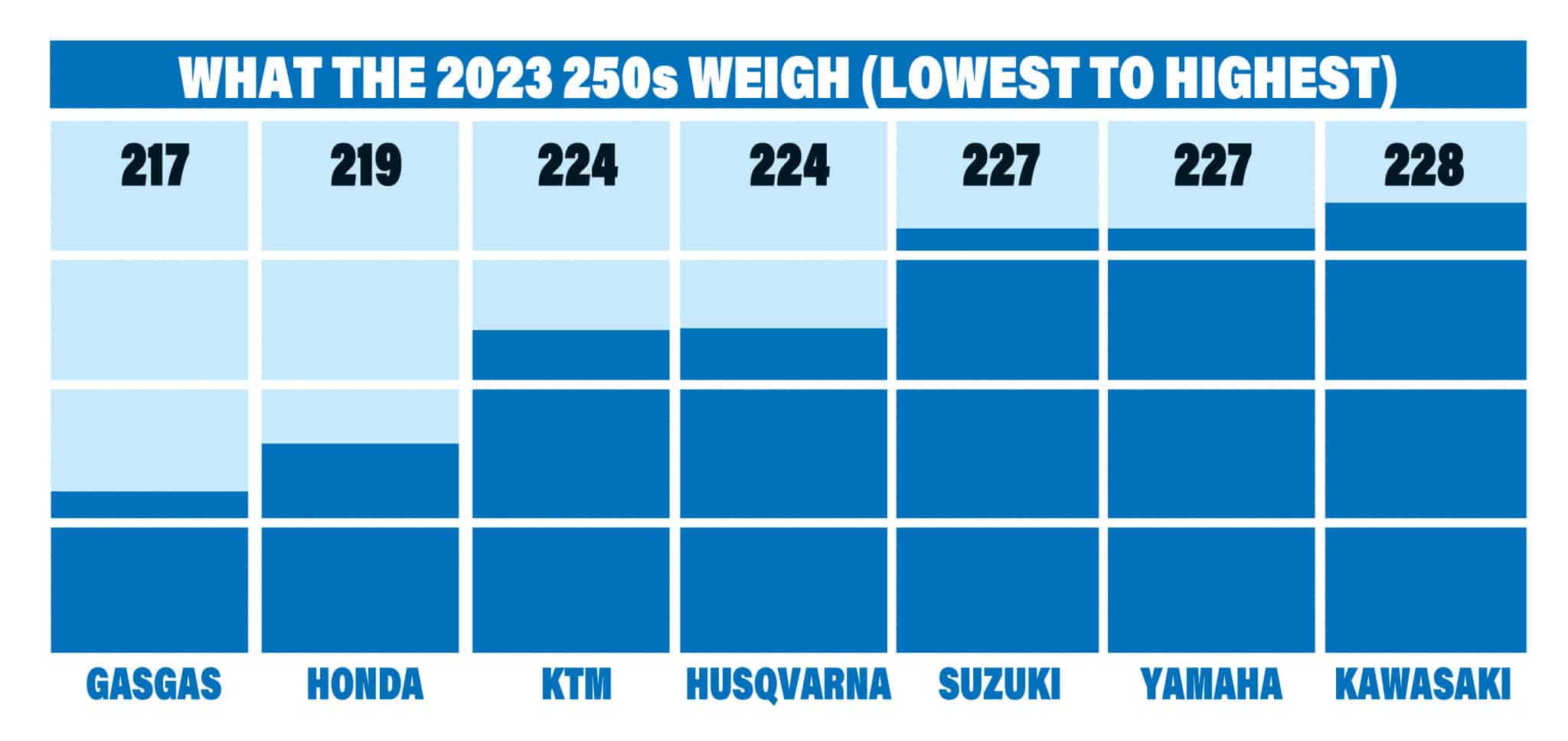
These are the actual weights in pounds of the current crop of 2023 250 motocross bikes (lightest to heaviest). They have been weighed on the same calibrated balance-beam scale under the official AMA and FIM system of empty gas tanks but all other fluids.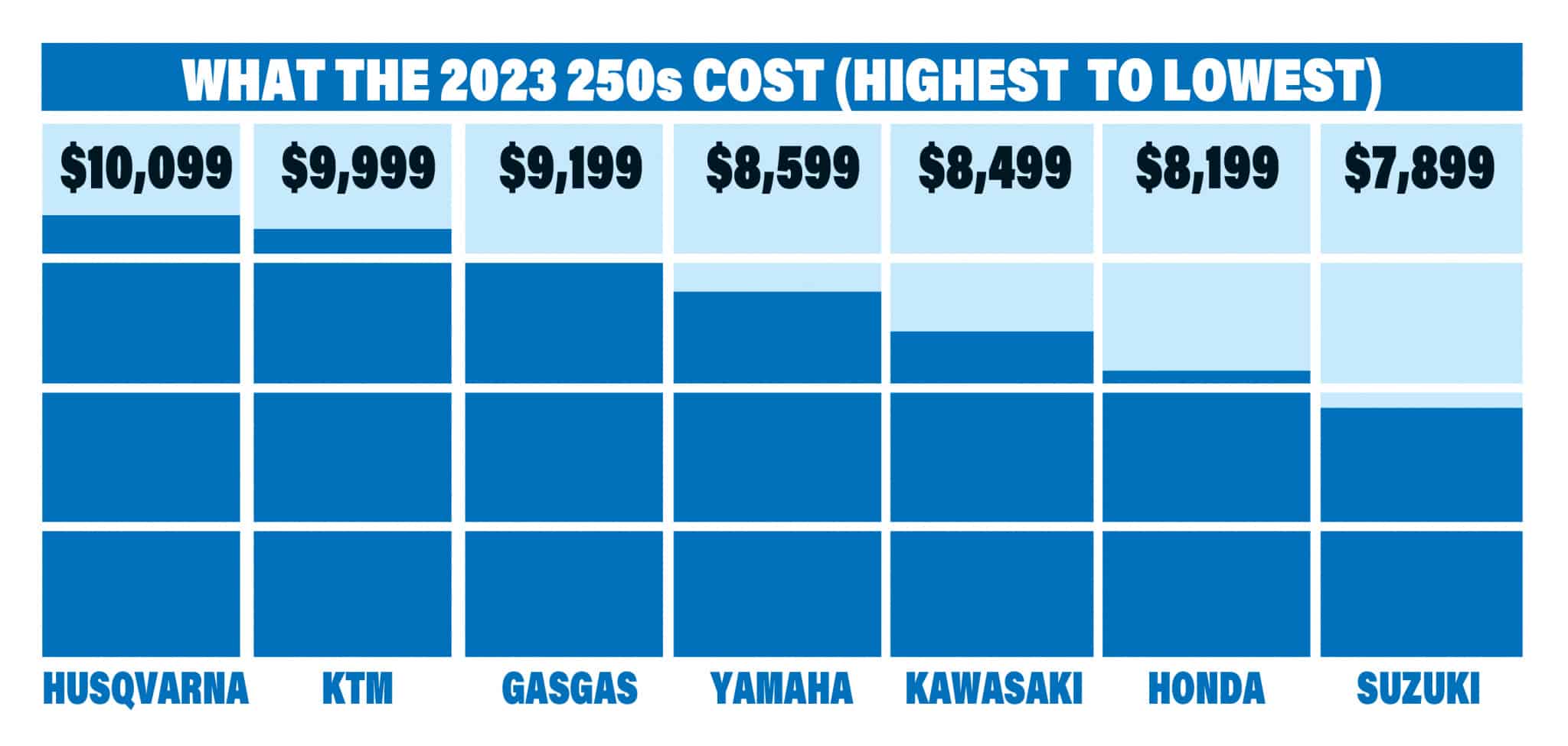
These are the Manufacturers’ Suggested Retail Prices (MSRPs) for all four 2023 250s (least to most expensive). Your local dealer is free to lower or raise the price of the bikes on their showroom floor. The price in the USA is determined by the exchange rate of the euro for European bikes and the yen for Japanese bikes.
Peak horsepower isn’t all that important in the 450 class, but it’s of higher value in the 250 four-stroke and 125 two-stroke ranks. All the 125s handle well, but if your bike is slow, you’ll be left behind. Here is how the 250 four-strokes stack up against each other.



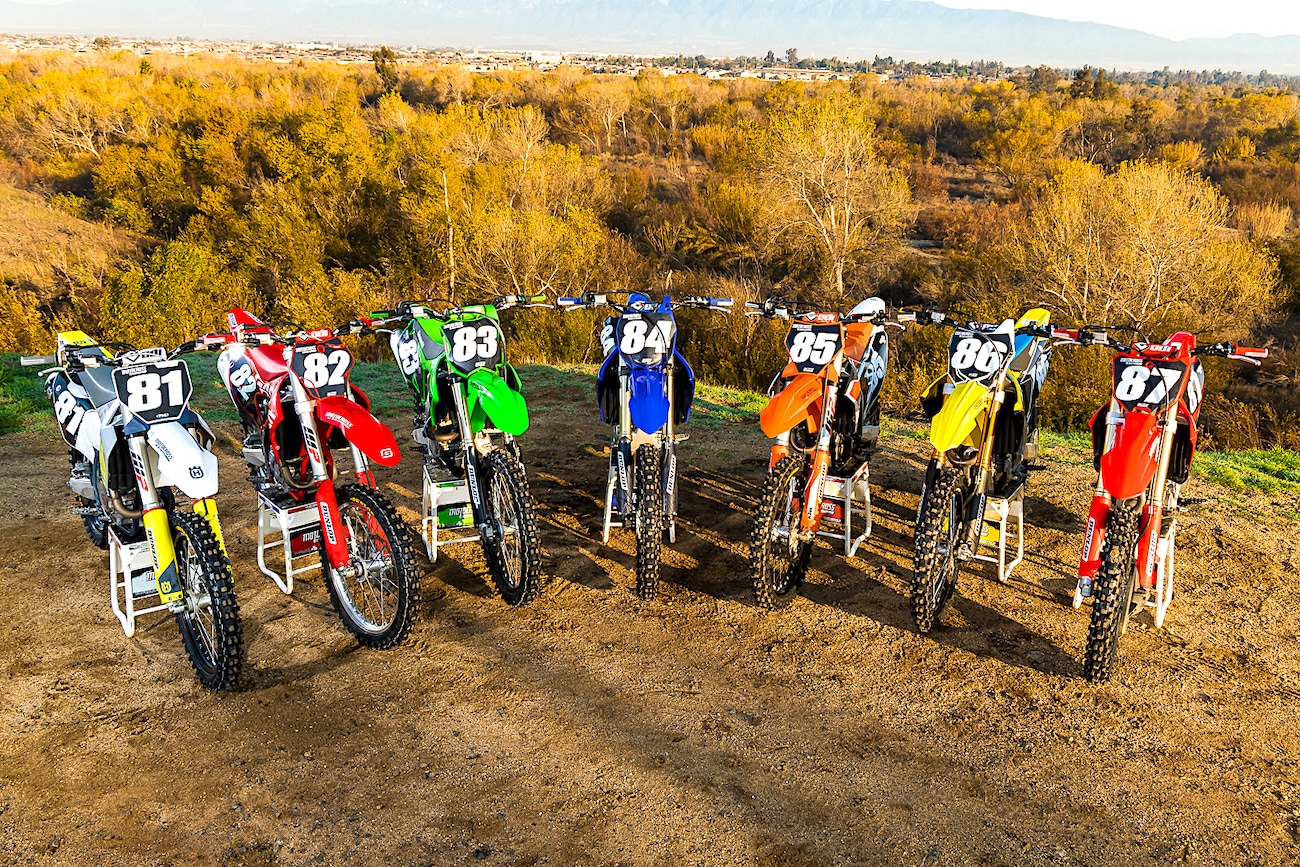
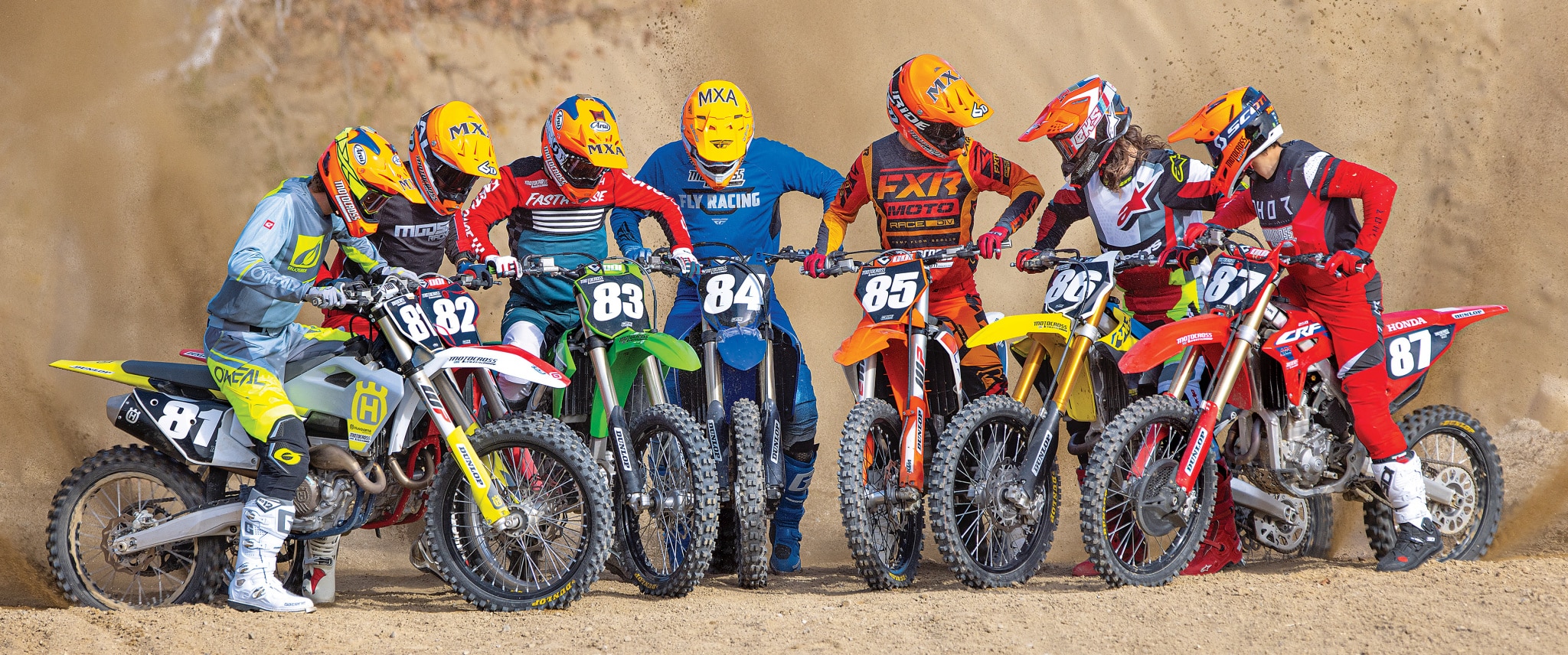
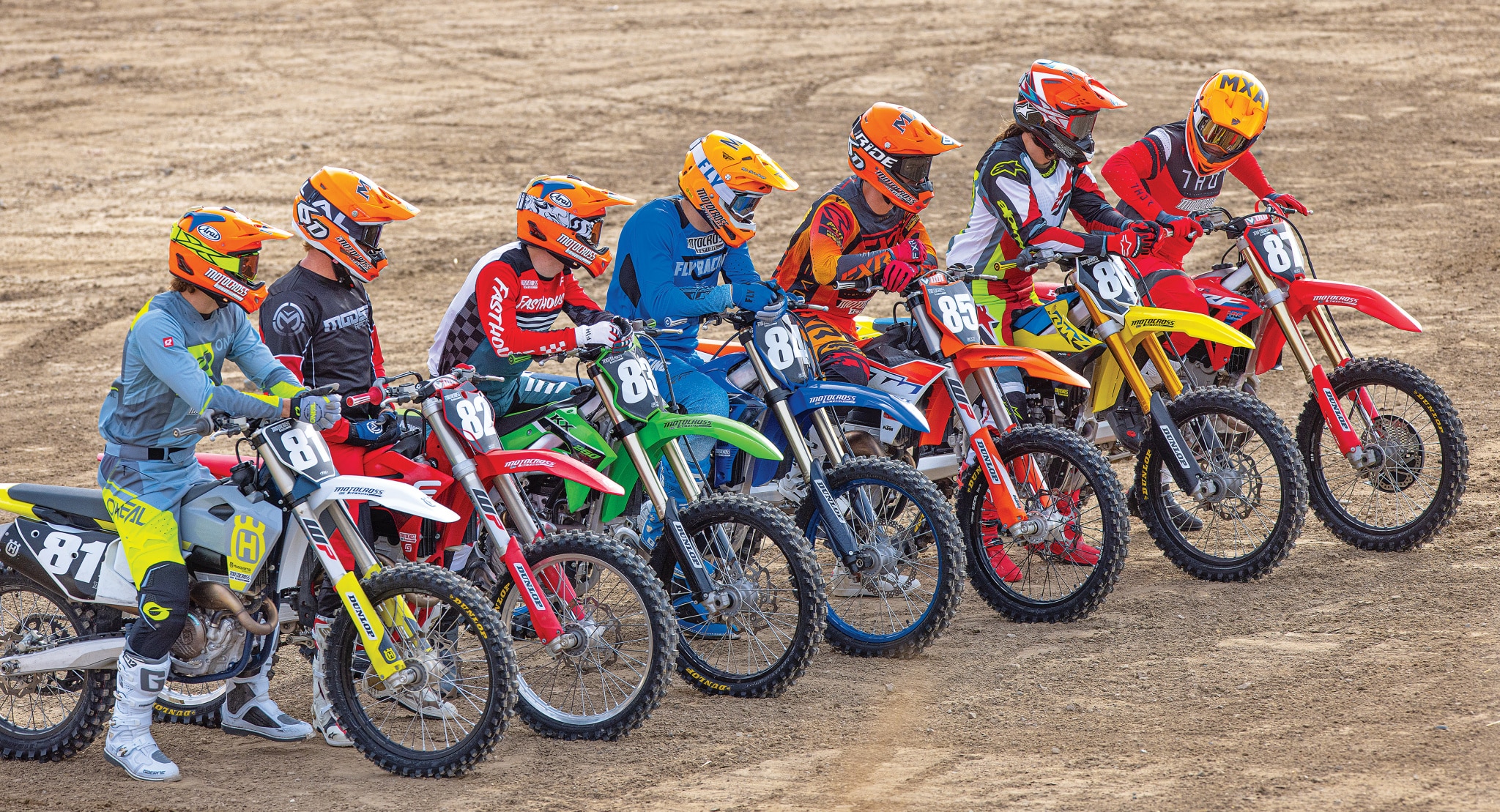
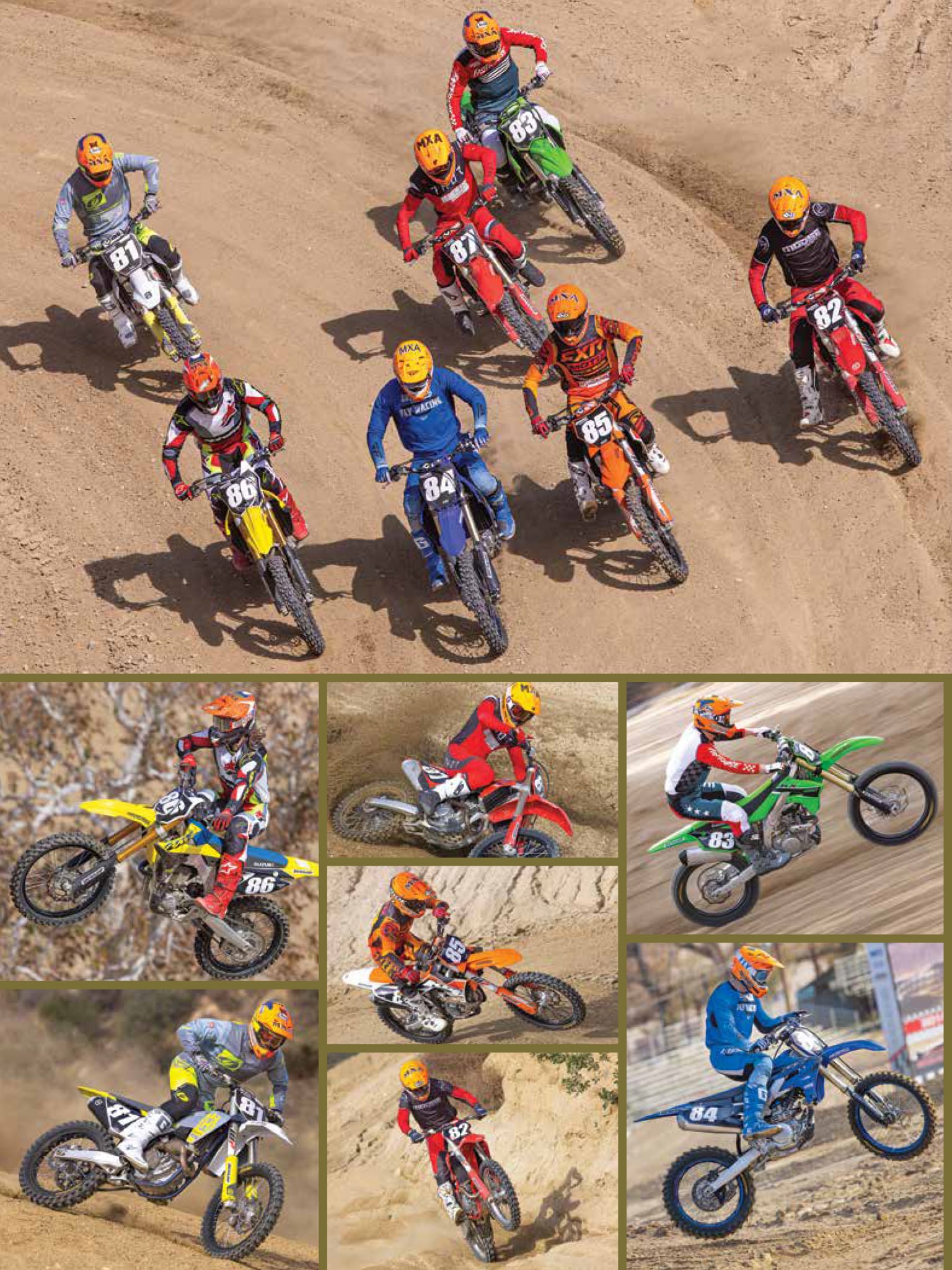
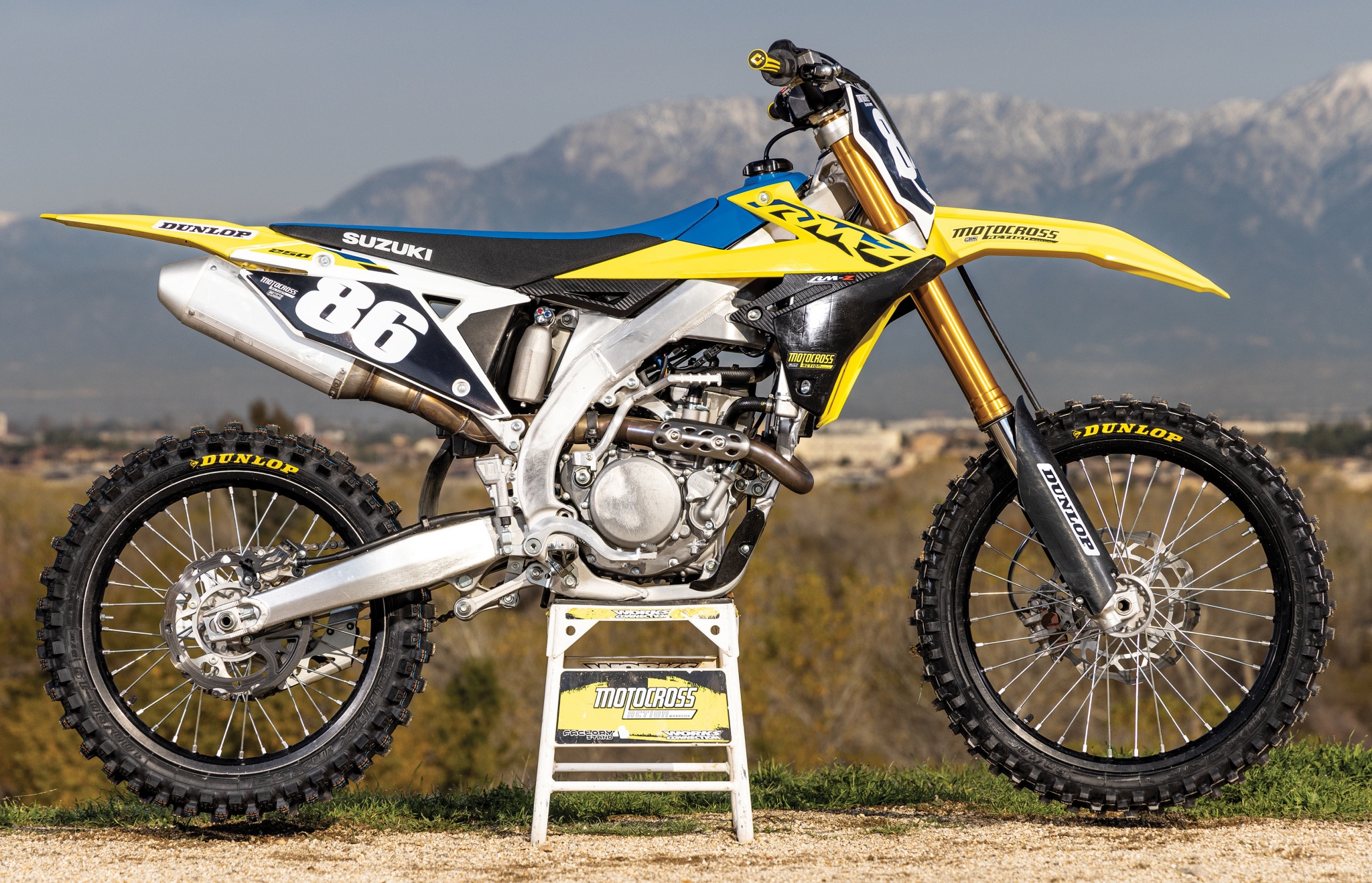
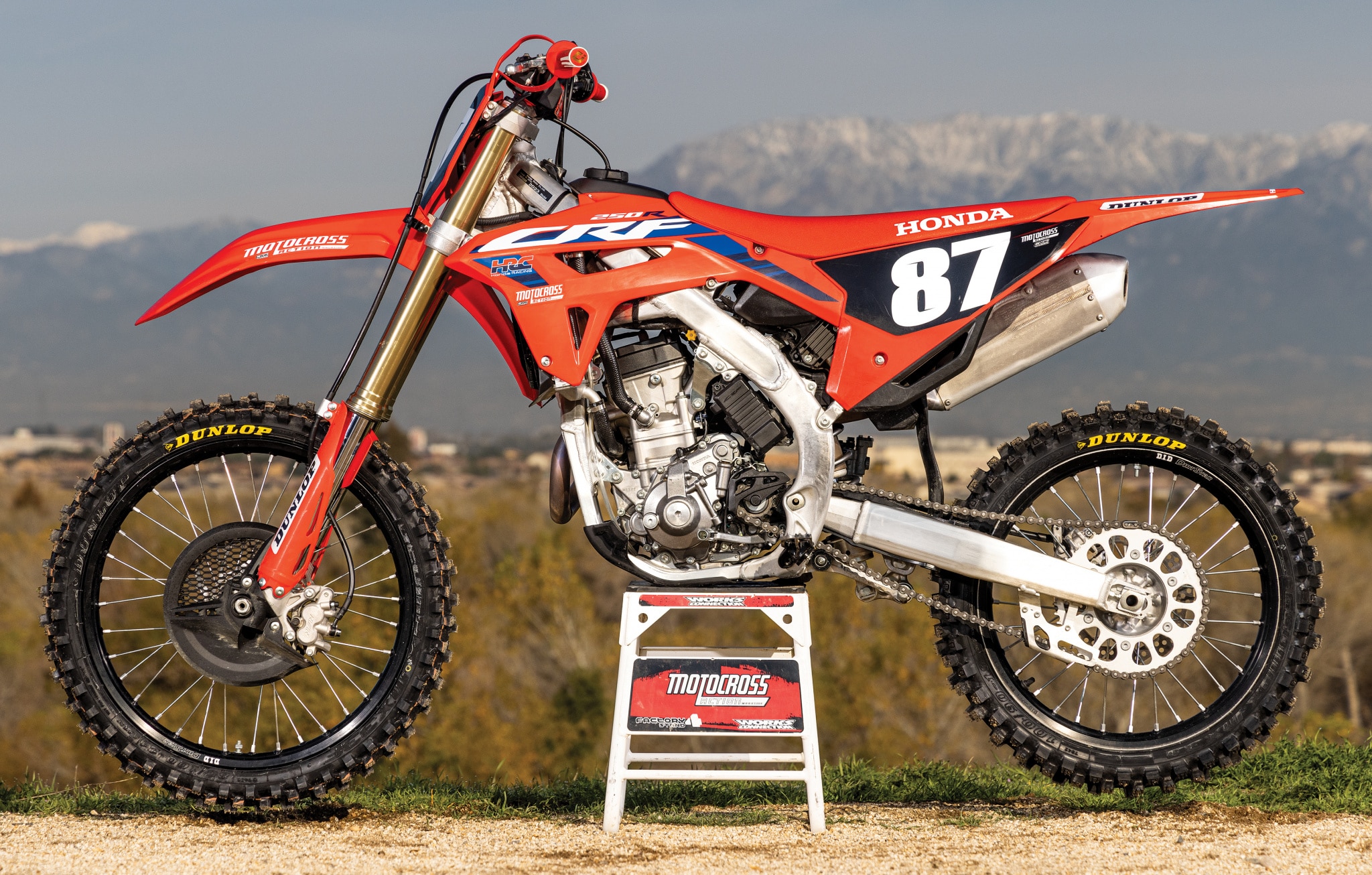


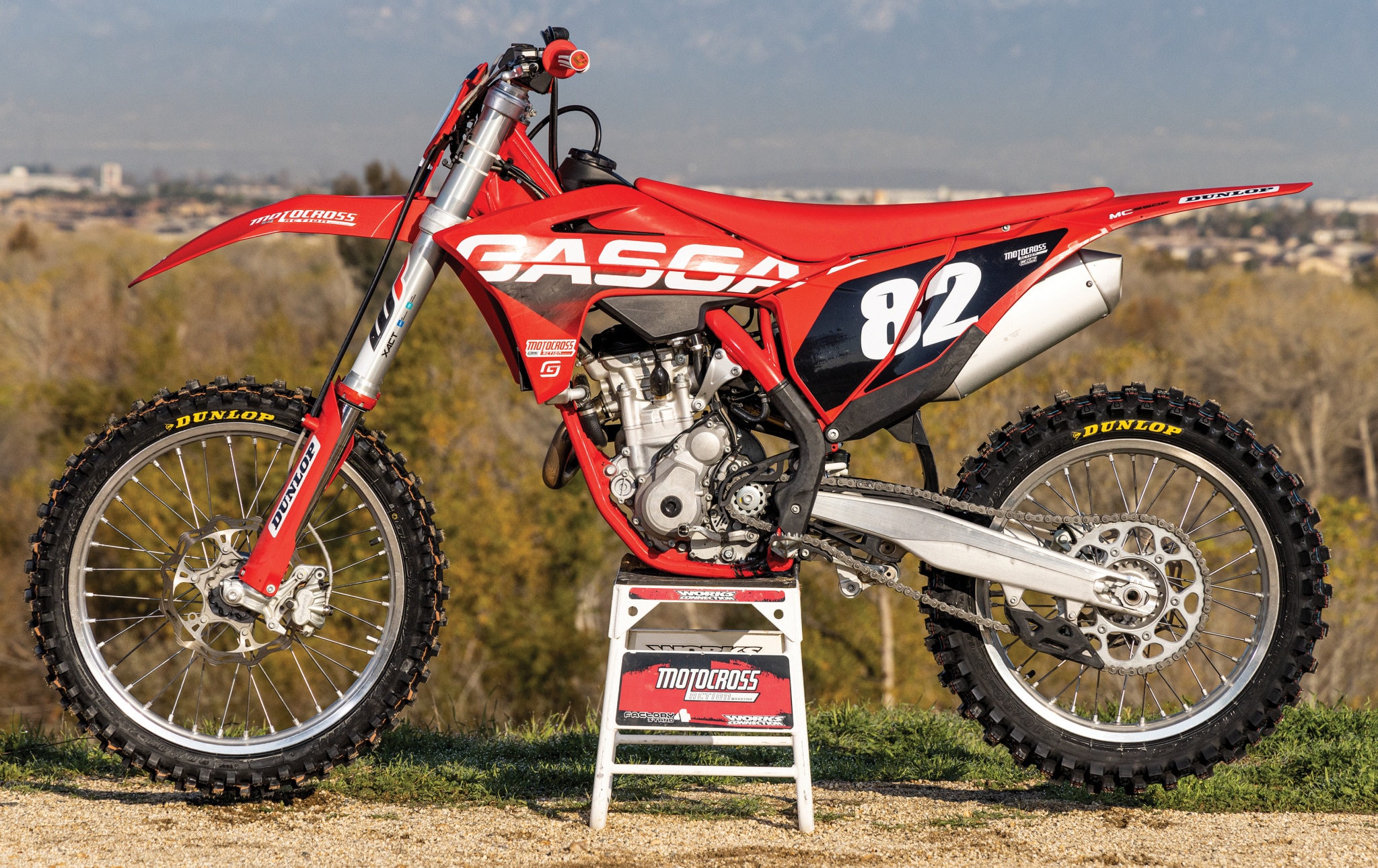

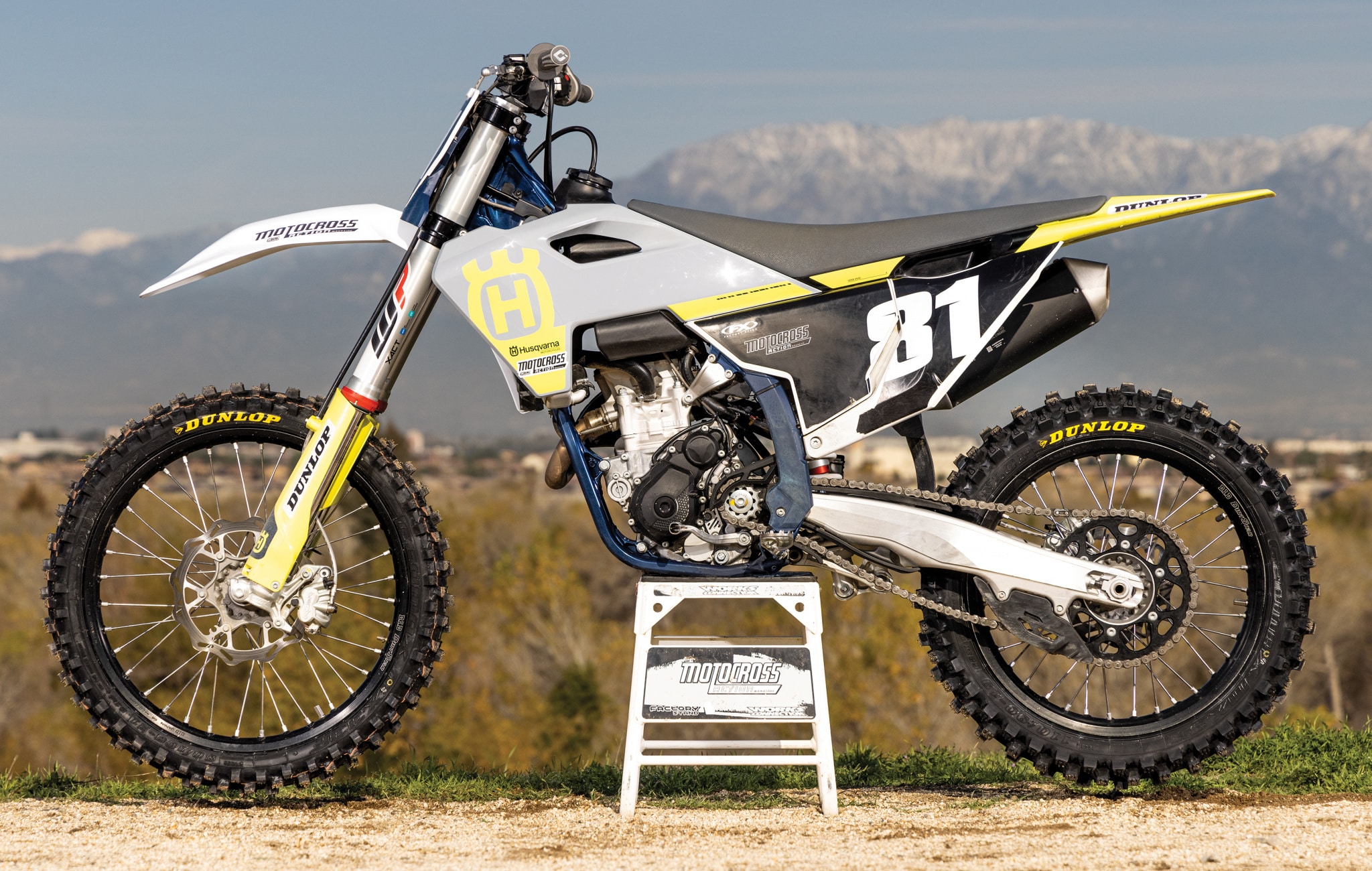
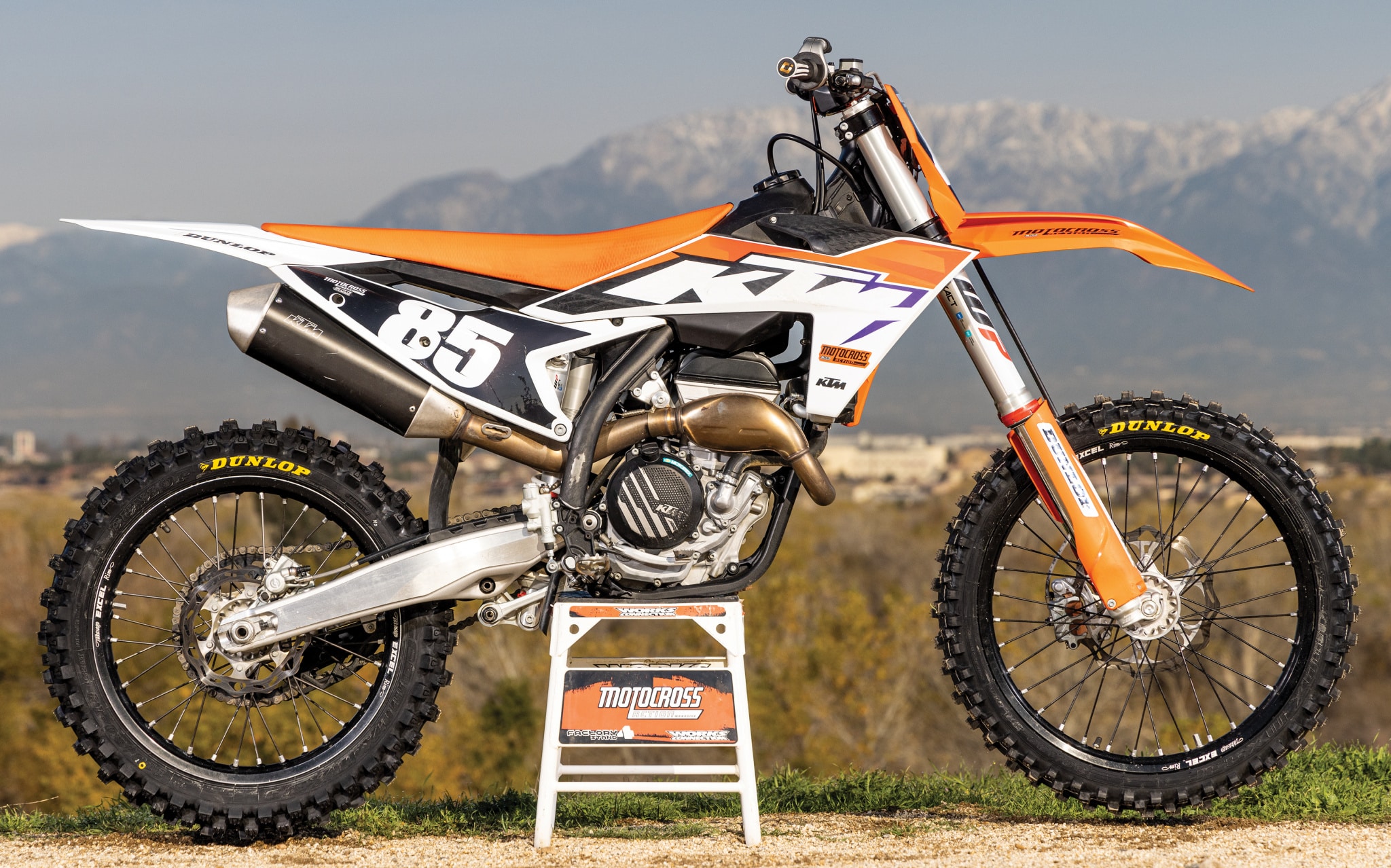
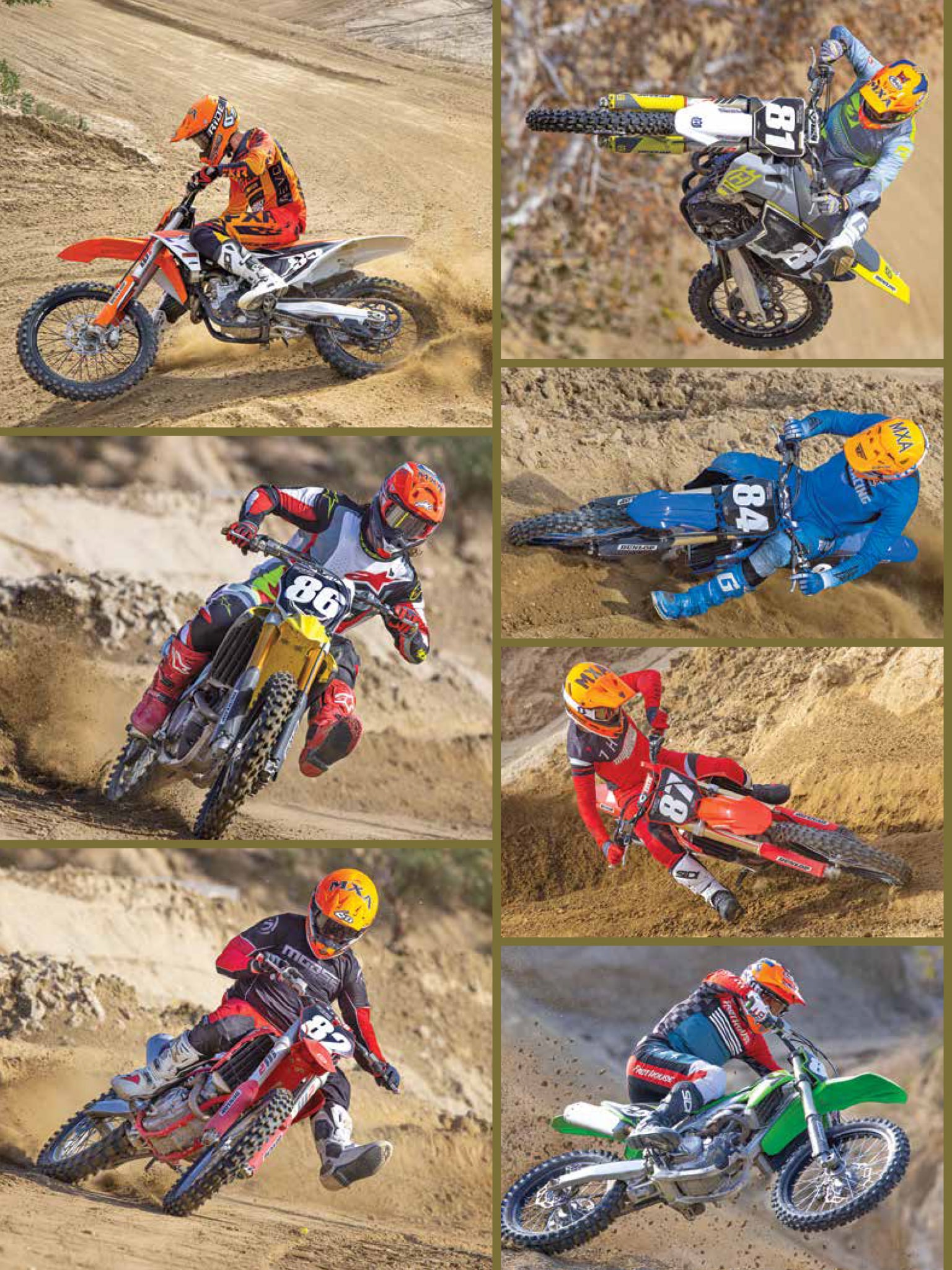



Comments are closed.